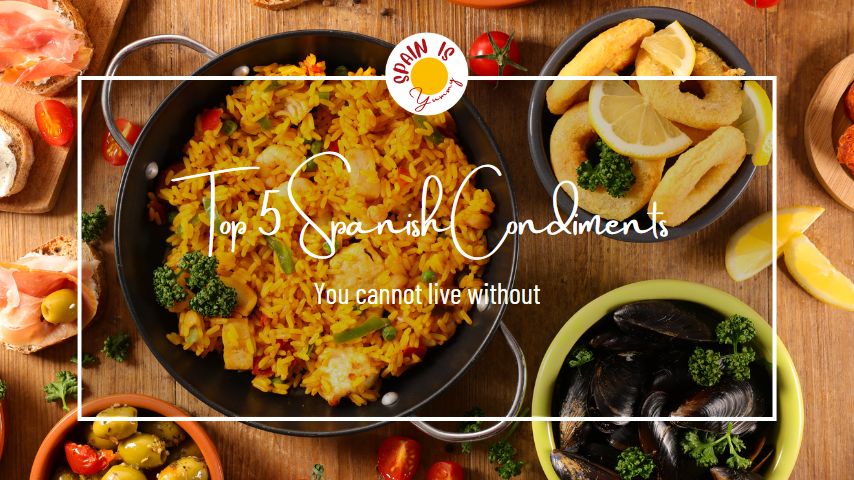

Have you ever wondered what makes Spanish cooking so Spanish? The cuisine in Spain thrives on its condiments and when you open the door of a Spanish kitchen you´d definitely experience at least one of the top Spanish condiments that round up the flavors and aromas of its plates, toasted garlic, sauteed onions, the deep aromas of Saffron and pimentón, all gathered around a drizzle of the best of olive oils. This article unveils the tip of the condiments iceberg in Spanish cooking. Ingredients that you could boldly use in many other dishes to give them the Spanish Olé spirit!
1. Extra virgin Olive Oil, Aceite de Oliva Virgen Extra


Aceite de oliva virgen extra or extra virgin olive oil, is a fundamental ingredient in Spanish cuisine, one of its main condiments strongly present in almost any savory Spanish dish. Its unique flavor and health benefits have made it a staple in the Spanish diet for centuries. Spain is the world’s largest producer of olive oil, with over 2.5 million tons produced each year, and much of it being of the highest quality, extra virgin.
Extra virgin Olive Oil: To be classified as extra virgin, olive oil must meet strict quality standards. It is made solely from pure, cold-pressed olives, and it must have an acidity level of less than 0.8%. This ensures that the oil has a high concentration of healthy monounsaturated fats, antioxidants, and vitamins.
In Spanish cooking, extra virgin olive oil is used in a variety of dishes, from salads and soups to stews and fried foods. It is often used as a finishing oil, drizzled over dishes just before serving to enhance their flavor. Its distinct fruity, grassy flavor can also be used to add depth and complexity to marinades and sauces.
One of the most famous Spanish dishes that relies heavily on extra virgin olive oil is gazpacho, a cold soup made with fresh vegetables, bread, and garlic. The oil is not only used in the soup itself but also as a garnish to enhance its flavor. Other classic Spanish dishes that feature extra virgin olive oil include paella, tortilla española, and alioli, a garlic-based sauce.
In Spanish recipes, Extra virgin Olive oil is often referred to as AOVE.
2. Spanish Saffron , La Mancha Saffron


Spanish saffron is one of the most sought-after spices in the world. Its delicate flavor and vibrant color make it a popular ingredient in many cuisines, especially in Spanish cooking. Among the different varieties of Spanish saffron, La Mancha saffron is considered to be the finest and most prized.
La Mancha saffron is produced in the province of La Mancha in central Spain. It has been awarded the PDO (Protected Designation of Origin) certificate, which means that it is a product with a unique quality and reputation due to its geographic origin, traditional production methods, and specific characteristics.
One of the main advantages of La Mancha saffron over other available saffrons on international levels is its exceptional quality. The production of La Mancha saffron is carefully monitored and controlled, ensuring that only the highest quality threads are selected for sale. This guarantees that chefs and home cooks alike can be confident in the quality of the saffron they are using, which is important given the high cost of this precious spice.
La Mancha saffron is harvested by hand, which is a labor-intensive process that involves picking the delicate stigmas of the crocus flower. These stigmas are then carefully dried to preserve their flavor and color. The resulting threads are then packaged and sold, with each package containing only a small amount of saffron, as a little goes a long way in terms of flavor and color.
In Spanish cooking saffron is an essential ingredient in many traditional dishes, such as paella, fabada Asturiana, arroz con pollo, and a wide variety of stews and soups. Its unique flavor and aroma enhance the taste of these dishes, giving them a distinctive Spanish flair. Moreover, Spanish saffron is also used in international cuisines, including French, Italian, and Indian cooking, among others.
Check our article for detailed information about La Mancha PDO Saffron.
3. Spanish Paprika, Pimentón


Spanish cuisine is renowned for its distinctive flavors and spices that add a unique touch to every dish. One such spice is pimentón, also known as Spanish paprika. Pimentón has become an essential ingredient in Spanish cooking, adding a distinctive flavor to various dishes. The two most prominent Spanish paprika spices are Pimentón de la Vera and Pimentón de Murcia.
Pimentón de la Vera is produced in the province of Cáceres, in the region of Extremadura, western Spain. The peppers used to make this type of pimentón are grown in the Vera region, where they are harvested and dried using traditional smoking techniques over oak wood fires. This process gives Pimentón de la Vera a smoky flavor and aroma, and it is the only Spanish paprika spice that holds a PDO (Protected Designation of Origin) certificate. The PDO certificate ensures that the product is produced and processed using traditional methods in a specific geographical area, giving it a unique identity.
Similarly, Pimentón de Murcia is also a PDO-protected spice made from a specific variety of pepper grown in the Murcia region of southeastern Spain. The peppers are dried ( not smoked) and ground to produce a rich, slightly sweet paprika spice that is used in many traditional Spanish dishes.
Spanish pimentón is widely recognized as one of the top Spanish condiments, known for its versatility in adding flavor to various dishes. It is used in traditional dishes like chorizo sausage, paella, and fabada stew, as well as in modern Spanish cuisine. Chefs around the world appreciate the unique flavor and aroma that pimentón brings to dishes, and it has become a popular ingredient in international cuisine.
4. Ajo / Spanish Garlic


Garlic, or ajo in Spanish, is one of the most important ingredients in Spanish cuisine, providing a unique flavor and aroma to many dishes. It is used in soups, stews, sauces, and even as a seasoning for roasted meats and vegetables. The culinary history of Spain is deeply rooted in garlic, and it is an essential ingredient in many of the country’s most famous dishes, such as gazpacho and paella.
One type of garlic that is highly prized in Spain is Ajo Morado de Las Pedroñeras. This garlic is grown exclusively in the town of Las Pedroñeras in the province of Cuenca and has been awarded the Protected Geographical Indication (PGI) certificate. The soil in this region is ideal for growing garlic, with a high content of limestone and clay, resulting in a unique flavor and texture.
The Ajo Morado de Las Pedroñeras is known for its intense and complex flavor profile, with a spicy kick and a hint of sweetness. It has a slightly softer texture compared to other garlic varieties, making it easier to peel and chop. It is also high in allicin, a compound that has been shown to have numerous health benefits, including anti-inflammatory and anti-cancer properties.
In addition to Ajo Morado de Las Pedroñeras, Spain is also known for its high-quality garlic in general. Spanish garlic has a reputation for being sweeter and less pungent than other varieties, making it a popular choice among chefs and home cooks alike.
5. Onions


Onions are a fundamental ingredient in Spanish cuisine, and their importance cannot be overstated. Used as a base in many dishes, onions provide a depth of flavor and complexity that enhances the taste of the dish. Whether caramelized, sautéed, or roasted, onions bring a unique and delicious taste to Spanish dishes.
One of the most popular varieties of onions used in Spanish cooking is the Cebolla de Fuente de Ebro. Grown in the Ebro Valley, this onion has a PDO (Protected Designation of Origin) certificate, which guarantees its quality and authenticity. The Cebolla de Fuente de Ebro has a sweet and delicate taste, making it ideal for both raw and cooked dishes.
In Spanish cuisine, onions are used in a variety of ways. They are a key ingredient in Spanish tortilla, a popular dish that is a staple in Spanish households. They are also used in sofrito, a sauce made from a blend of onions, tomatoes, and garlic that is used as a base in many Spanish dishes, including paella and arroz con pollo.
Onions are also used to add flavor to soups, stews, and sauces. In fact, many Spanish dishes would not be complete without the addition of onions. They are used in combination with other ingredients to create a rich and complex flavor profile that is unique to Spanish cuisine.
Our list does not take into account other Spanish condiments widely used in Spanish cooking, herbs, spices, and key repeated ingredients are what identify this cuisine that so heavily relies on fresh natural products. Share with us your favorite and let us know if you use it to give international dishes a Spanish zest.
